Rajneet Kohli Appointed as Executive Director of Foods at HUL
Syllabus:Polity
Key Appointment
- Rajneet Kohli to assume role at Hindustan Unilever (HUL) from April 7, 2025
- Succeeds Shiva Krishnamurthy, who is stepping down for an external opportunity
Professional Background
- Former CEO & Executive Director at Britannia Industries (until March 14, 2025)
- Brings 30 years of experience in consumer and retail sectors
- Previously worked with Asian Paints, Coca-Cola, Jubilant FoodWorks, and Britannia
HUL’s Foods & Refreshment Business
- Includes brands like Kissan, Bru, Knorr, Brooke Bond, Horlicks, Lipton, and Hellmann’s
- Contributed ₹15,292 crore in revenue (FY24), 25% of HUL’s total turnover
Kohli’s Impact at Britannia
- Strengthened Britannia’s leadership in the food and bakery segment
- Led product innovation and digital transformation
- Recent Leadership Changes at HUL
- Rohit Jawa – MD & CEO (since June 2023)
- Harman Dhillon – Executive Director, Beauty & Well-being (2023)
- Arun Neelakantan – Executive Director, Customer Development (June 2024)
- Kohli’s leadership is expected to further accelerate HUL’s growth in the foods and refreshment segment
With reference to corporate leadership transitions in FMCG companies, consider the following statements:
- Rajneet Kohli’s appointment as Executive Director – Foods & Refreshment at HUL marks his first leadership role in the FMCG sector.
- The Foods & Refreshment segment contributes over one-third of Hindustan Unilever’s total revenue.
- Kohli’s prior experience includes leadership roles in multinational corporations across multiple consumer-driven industries.
Which of the statements given above is/are correct?
(a) 1 only
(b) 2 and 3 only
(c) 3 only
(d) 1, 2, and 3
Answer: (c) 3 only
Explanation:
- Statement 1 is incorrect: Rajneet Kohli has previously held leadership roles in Britannia, Coca-Cola, Jubilant FoodWorks, and Asian Paints, making this not his first leadership role in the FMCG sector.
- Statement 2 is incorrect: The Foods & Refreshment segment contributed ₹15,292 crore in FY24, which is 25% of HUL’s total revenue, not over one-third.
- Statement 3 is correct: Kohli has extensive experience across multiple consumer sectors, including food, beverages, paints, and quick-service restaurants.
Cabinet Approves 2% Hike in DA for Government Employees
Syllabus: Polity
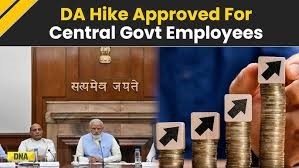
Key Highlights:
- Increase in DA/DR: Raised from 53% to 55% of Basic Pay/Pension.
- Effective Date: January 1, 2025.
Beneficiaries:
- Central Government Employees:66 lakh.
- Pensioners:55 lakh.
Financial Impact:
- Estimated additional burden on the exchequer: ₹6,614.04 crore per annum.
Background:
- DA is revised twice a year (January and July), based on the All India Consumer Price Index for Industrial Workers (AICPI-IW).
- Last revision: July 2024, when DA increased from 50% to 53%.
- Calculation follows the 7th Central Pay Commission’s
Purpose of DA/DR:
- Designed to offset inflation and preserve the purchasing power of government employees.
- Increasing speculation about the 8th Pay Commission has heightened interest in DA revisions.
With reference to the recent increase in Dearness Allowance (DA) and Dearness Relief (DR) by the Union Government, consider the following statements:
- The DA hike is determined solely based on the Wholesale Price Index (WPI) to account for inflationary trends.
- The increase in DA is applicable only to central government employees and does not extend to pensioners.
- The 7th Central Pay Commission provides the formula for DA calculation, which is revised twice a year.
Which of the statements given above is/are correct?
(a) 1 only
(b) 3 only
(c) 1 and 2 only
(d) 2 and 3 only
Answer: (b) 3 only
Explanation:
- Statement 1 is incorrect: The DA hike is based on the All India Consumer Price Index for Industrial Workers (AICPI-IW), not the Wholesale Price Index (WPI). The AICPI-IW reflects the cost of living and inflation experienced by government employees.
- Statement 2 is incorrect: DA is applicable to both government employees and pensioners, in the form of DA for serving employees and Dearness Relief (DR) for pensioners.
- Statement 3 is correct: The 7th Central Pay Commission provides the formula for DA revision, which is revised biannually (January and July) based on AICPI-IW.
Panel Recommends Framework for Direct Recruitment in CBI
Syllabus: GS2/Governance
Key Recommendations
Independent Recruitment Framework:
- Currently, many posts are filled through deputation from various organizations.
- The committee suggests an independent recruitment system for CBI.
- Recruitment could be conducted via SSC, UPSC, or a dedicated CBI examination.
- Lateral entry should be introduced for experts in cybercrime, forensics, financial fraud, and legal fields.
- Deputation should be limited to senior posts only.
- CBI should develop an in-house expertise team to reduce reliance on external specialists.
State Consent for Investigations:
- The committee recommends a new law allowing CBI to investigate cases related to national security and integrity without requiring state government consent.
- The law should include safeguards to maintain neutrality and prevent undue influence.
Permanent Cadre Establishment:
- CBI should create a permanent cadre with structured career growth.
- This would provide stability and reduce dependency on officers from other agencies.
- Challenges Faced by CBI
Lack of Autonomy & Operational Constraints:
- CBI operates under the Delhi Special Police Establishment (DSPE) Act, 1946, which limits its independence.
- Investigations require state government consent, leading to frequent delays and political hurdles.
- Eight states have withdrawn general consent, restricting CBI’s jurisdiction.
Manpower Shortages:
- Nearly 16% of sanctioned positions remain vacant, affecting investigations.
Dependence on Deputation:
- CBI struggles to fill posts below inspector rank due to a shortage of suitable state police officers.
About the Central Bureau of Investigation (CBI)
- Established: 1963, based on the Santhanam Committee’s recommendations on corruption prevention.
- Ministry: Operates under the Ministry of Personnel, Public Grievances, and Pensions.
Jurisdiction:
- Requires state government consent for investigations unless covered under general consent.
Leadership:
- The CBI Director is appointed for a fixed two-year tenure based on recommendations from a three-member Appointment Committee.
- The committee’s recommendations aim to enhance CBI’s independence, efficiency, and expertise, ensuring it remains a robust investigative agency.
Regarding the recruitment process in the Central Bureau of Investigation (CBI), consider the following statements:
- The majority of CBI personnel are recruited independently through a dedicated CBI examination.
- Deputation from other government agencies remains the primary mode of filling key posts in CBI.
- The Parliamentary Committee has recommended lateral entry for specialists in cybercrime, forensics, and financial fraud.
Which of the statements given above is/are correct?
(a) 1 and 3 only
(b) 2 and 3 only
(c) 1 and 2 only
(d) 1, 2, and 3
Answer: (b) 2 and 3 only
Explanation:
- Statement 1 is incorrect: CBI does not have an independent recruitment system; most of its positions are filled through deputation from other agencies such as state police and paramilitary forces.
- Statement 2 is correct: Deputation remains the predominant method of recruitment for CBI personnel.
- Statement 3 is correct: The Parliamentary Committee has recommended lateral entry for specialists in cybercrime, financial fraud, and forensics to enhance expertise.
The Medical Termination of Pregnancy (MTP) in India
Syllabus: GS2/Health
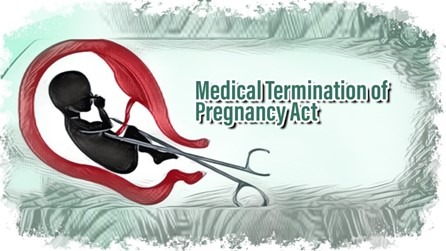
Concerns Among Medical Professionals
- Some doctors experience ethical discomfort in performing abortions, particularly in later stages of pregnancy.
- The debate over fetal viability becomes more intense as gestation advances, raising legal and moral dilemmas.
Understanding Fetal Viability
- Fetal viability refers to the stage at which a fetus can survive outside the womb.
- There is no universally agreed-upon moment of viability, making it a contentious issue in ethical and legal discussions.
- As pregnancy progresses, the fetus’s right to life is perceived to strengthen, intensifying debates on abortion laws.
India’s Legal Framework on Abortion
Evolution of Abortion Laws
- Before 1971, abortion was regulated under the Indian Penal Code (IPC), primarily criminalizing the procedure, except when performed in good faith to save the woman’s life.
- The IPC did not distinguish between wanted and unwanted pregnancies, creating significant barriers to safe abortion access.
The Medical Termination of Pregnancy (MTP) Act, 1971
- Enacted as a health measure to decriminalize abortion in specific cases under the supervision of registered medical practitioners.
Key provisions:
- Abortions permitted up to 20 weeks under defined conditions.
- Up to 12 weeks: Requires approval from one doctor.
- 12 to 20 weeks: Requires approval from two doctors.
- The MTP (Amendment) Act, 2021
- Extended abortion limit to 24 weeks for specific categories, including:
- Survivors of rape and incest.
- Women experiencing a change in marital status during pregnancy.
- Other vulnerable women (e.g., minors, differently-abled women).
- The term “any married woman or her husband” was replaced with “any woman or her partner”, recognizing pregnancies outside marriage.
Beyond 24 weeks:
- Requires approval from a medical board in each district.
- Permitted only in cases of substantial fetal abnormalities.
Arguments Supporting the MTP Act
- Bodily Autonomy & Reproductive Rights
- Women should have the right to make decisions regarding their own bodies.
- The Supreme Court has upheld reproductive rights as part of personal liberty under Article 21.
Protection of Physical Health
- Abortion may be essential if continuing the pregnancy threatens the woman’s life or health (e.g., gestational diabetes, eclampsia).
Mental Health Considerations
- Pregnancy may worsen pre-existing mental health conditions like depression, anxiety, or postpartum psychosis.
- Access to abortion can prevent psychological distress.
Non-Viable Fetuses
- Abortion may be justified when fetal congenital abnormalities are incompatible with life, preventing prolonged suffering.
Unplanned Pregnancies
- Women facing economic hardships or social challenges should have the choice to terminate an unintended pregnancy.
Reduction in Unsafe Abortions
- Legal abortion access minimizes unsafe procedures that pose serious health risks, reducing maternal mortality.
Arguments Against the MTP Act
Right to Life of the Fetus
- The fetus’s right to life is considered to strengthen with gestational age, making abortion ethically contentious.
Psychological Consequences for Women
- Some women experience long-term emotional distress, including guilt, regret, and trauma post-abortion.
Concerns Over Non-Medical Abortions
- Fear that abortion may be used as a form of contraception, rather than a medically necessary intervention.
Risk of Misuse
- Potential for sex-selective abortions, despite laws prohibiting the practice.
- Loopholes may allow abortion for reasons unrelated to medical necessity.
Impact on Societal and Cultural Norms
- Widespread abortion may alter societal values regarding family and life.
- Many cultures consider abortion morally unacceptable and contrary to religious beliefs.
Way Forward
- Enhancing Access to Safe Abortion Services
- Increase availability of MTP pills and reduce administrative hurdles.
- Ensure that abortion is treated as a healthcare service rather than an exceptional legal provision.
- Strengthening Sex Education & Awareness
- Comprehensive sexual education can help reduce unwanted pregnancies.
- Address stigma surrounding abortion and reproductive rights.
- Empathy in Medical Decision-Making
- Healthcare professionals should be encouraged to approach abortion cases with compassion and understanding.
- Particularly important in late-term abortions, where ethical conflicts intensify.
- By balancing women’s reproductive rights, fetal viability concerns, and ethical considerations, India can move towards a more inclusive and comprehensive approach to abortion laws.
Consider the following statements regarding the concept of fetal viability:
- It refers to the stage at which a fetus can survive outside the mother’s womb.
- It has a universally accepted gestational threshold.
- It plays a significant role in determining the legality of abortion in many countries.
Which of the statements given above is/are correct?
(a) 1 and 2 only
(b) 1 and 3 only
(c) 2 and 3 only
(d) 1, 2, and 3
Answer: (b) 1 and 3 only
Explanation:
- Statement 1 is correct: Fetal viability refers to the ability of a fetus to survive outside the womb, usually considered to be around 24-28 weeks of gestation, but this varies with medical advancements.
- Statement 2 is incorrect: There is no universally accepted gestational threshold for viability, as it depends on medical technology and healthcare access.
- Statement 3 is correct: The concept of fetal viability significantly influences legal abortion frameworks, as seen in India’s MTP Act and global abortion laws.
10th Anniversary of Sagarmala Programme
Syllabus: GS3/ Infrastructure
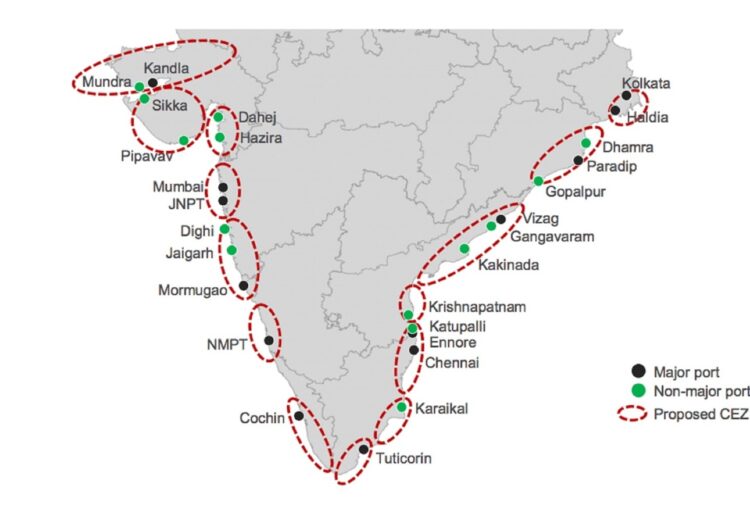
Sagarmala 2.0
- Building upon the original program, Sagarmala 2.0 focuses on:
- Strengthening stakeholder collaboration for better project execution.
- Enhancing port-led industrial clusters to boost economic output.
- Expanding coastal shipping, inland waterways, and logistics hubs.
Sagarmala Startup Innovation Initiative (S2I2)
- Launched on March 19, 2025, the Sagarmala Startup Innovation Initiative aims to foster innovation and entrepreneurship in India’s maritime sector.
Key Focus Areas:
- Green Shipping – Promoting sustainable and eco-friendly maritime solutions.
- Smart Ports – Integrating artificial intelligence, automation, and digitalization in port operations.
- Maritime Logistics – Improving supply chain efficiency.
- Shipbuilding Technology – Advancing indigenous ship design and manufacturing.
- Sustainable Coastal Development – Ensuring environmental responsibility.
- The initiative follows the guiding principle of Research, Innovation, Startups, and Entrepreneurship.
Challenges and Roadblocks
Despite its progress, the Sagarmala Programme faces several challenges:
- Investment and Budgetary Constraints – Delays in funding allocation hinder timely project completion.
- Land Acquisition and Environmental Concerns – Legal and ecological complexities slow infrastructure development.
- Stakeholder Coordination Issues – Effective implementation requires seamless cooperation among central and state governments, port authorities, and private investors.
- Connectivity Gaps – Limited last-mile connectivity between ports and industrial hubs reduces efficiency.
- Community and Social Impact – Port expansions lead to the displacement of fishing communities, affecting their livelihoods.
Way Forward: Strengthening India’s Maritime Future
- Enhancing Inter-Agency Coordination – Strengthening collaboration across government and private sectors for better execution.
- Sustainable and Green Ports – Developing environmentally friendly ports with a focus on renewable energy and emissions reduction.
- Improving Port-Hinterland Connectivity – Investing in multi-modal transport networks to optimize cargo movement.
- Boosting Indigenous Shipbuilding and Recycling – Strengthening Make in India initiatives in maritime infrastructure and vessel manufacturing.
By addressing these challenges, the Sagarmala Programme will play a critical role in transforming India into a global maritime leader by 2047.
With reference to the Sagarmala Programme, consider the following statements:
- The programme aims to enhance India’s maritime logistics efficiency primarily by expanding port-led infrastructure rather than promoting coastal shipping.
- The Sagarmala Programme is aligned with the Maritime Amrit Kaal Vision 2047, which envisions India among the top five shipbuilding nations globally.
- The Sagarmala Development Company Limited (SDCL) was established to execute all port-related projects directly under the Ministry of Ports, Shipping, and Waterways.
Which of the statements given above is/are correct?
(a) 1 and 2 only
(b) 2 only
(c) 1 and 3 only
(d) 2 and 3 only
Answer: (b) 2 only
Explanation:
- Statement 1 is incorrect: The Sagarmala Programme focuses on shifting from infrastructure-heavy transport models to efficient coastal shipping and inland waterway networks, rather than solely relying on port-led expansion.
- Statement 2 is correct: The programme aligns with the Maritime Amrit Kaal Vision 2047, which aims to position India among the top five shipbuilding nations.
- Statement 3 is incorrect: The Sagarmala Development Company Limited (SDCL) was created to provide financial support to project Special Purpose Vehicles (SPVs) but does not execute projects directly under the ministry.
Free Movement Regime between India and Myanmar
Syllabus: GS2/IR/GS3/Internal Security
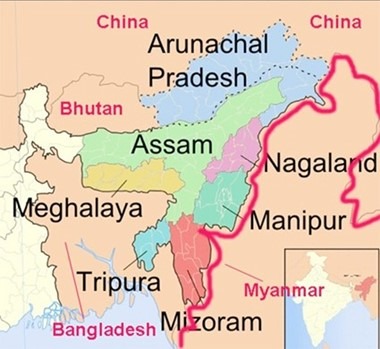
Background
- In 2024, the Union Home Minister announced the decision to abolish the Free Movement Regime (FMR) along the Myanmar border. However, no substantial progress has been made in implementing this decision.
Understanding the Free Movement Regime (FMR)
- The Free Movement Regime (FMR) is a bilateral arrangement between India and Myanmar that permits border communities to cross into each other’s territory without a visa.
- Established in 1968, FMR was introduced due to deep familial and ethnic ties shared by tribes living along the border.
- Initially, the regime allowed movement up to 40 km inside the other country’s territory.
- However, in 2004, this limit was reduced to 16 km, followed by additional regulatory measures introduced in 2016.
Rationale Behind Scrapping FMR
Internal Security Concerns
- Myanmar’s ongoing instability, along with the presence of armed groups, has led to an increase in unauthorized migration, creating security challenges for India.
Drug Trafficking
- Myanmar is part of the infamous Golden Triangle, one of the world’s major hubs for illicit drug production and smuggling. The porous border facilitates the influx of narcotics into India, exacerbating drug-related problems in the Northeast.
Insurgent Activities
- Several insurgent groups operate from across the border in Myanmar, using dense forests as a safe haven. The existing FMR enables their movement and logistical support, posing a threat to India’s internal security.
Influx of Refugees
- Escalating violence in Myanmar has led to an increased flow of refugees into India, particularly affecting Manipur and Mizoram. This has resulted in social, economic, and administrative challenges for Indian states.
China’s Expanding Influence
- Following the 2021 military coup in Myanmar, the country has become increasingly dependent on China, which provides diplomatic and economic support. While Myanmar previously sought to diversify its international partnerships, its growing reliance on China raises strategic concerns for India.
India-Myanmar Relations: A Strategic Overview
Geographical Proximity
- India and Myanmar share both a land and maritime boundary in the Bay of Bengal.
- Four northeastern Indian states—Arunachal Pradesh, Nagaland, Manipur, and Mizoram—share borders with Myanmar.
Historical and Cultural Linkages
- India and Myanmar share centuries-old historical, religious, and cultural connections, with influences from Buddhism, Hinduism, and ancient trade routes shaping bilateral interactions.
- India and Myanmar signed the Treaty of Friendship in 1951, laying the foundation for their diplomatic relations.
Geopolitical Significance
- Myanmar’s strategic location makes it a vital bridge between South Asia and Southeast Asia.
- India’s Act East Policy and Neighborhood First Policy emphasize strengthening ties with Myanmar to enhance regional connectivity and economic cooperation.
Economic and Trade Relations
- Bilateral trade between India and Myanmar reached USD 1.50 billion in 2023-24.
Trade is conducted under:
- ASEAN-India Trade in Goods Agreement (AITIGA)
- India’s Duty-Free Tariff Preference (DFTP) scheme
Security Cooperation
- India and Myanmar collaborate on border security, counterinsurgency operations, and intelligence sharing.
- Joint patrolling and military operations have been conducted to counter insurgent groups operating across the border.
Connectivity and Infrastructure Initiatives
- India is actively involved in major connectivity projects to enhance trade and infrastructure development:
- Kaladan Multi-Modal Transit Transport Project (KMMTTP) – A key initiative to improve connectivity between India’s northeastern states and Myanmar via maritime and land routes.
- India-Myanmar-Thailand Trilateral Highway – A crucial project aimed at bolstering economic integration between the three countries.
- Sittwe Port in Myanmar’s Rakhine State – A strategically significant port under KMMTTP, providing India an alternative trade route bypassing the congested Siliguri Corridor.
Developmental Assistance
- India has extended assistance in multiple sectors, including healthcare, education, skill development, and infrastructure.
- India and Myanmar collaborate under multilateral frameworks such as BIMSTEC and Mekong-Ganga Cooperation (MGC).
Way Forward
Regulated Border Management
- India must develop a structured mechanism to monitor cross-border movement while balancing security and humanitarian considerations.
- Deploying advanced surveillance technologies and strengthening border infrastructure will be crucial.
Public Awareness and Stakeholder Consultation
- It is imperative for the Indian government to educate local communities and stakeholders about the implications of FMR and its potential removal.
- Consultation with northeastern state governments and indigenous communities will help in formulating an inclusive border policy.
Sustainable Refugee Policy
- India needs a well-defined refugee policy to manage the influx of displaced individuals from Myanmar while ensuring national security.
- International collaboration with organizations like UNHCR can aid in managing refugee challenges.
Strategic Engagement with Myanmar
- India must continue engaging diplomatically with Myanmar’s ruling establishment to safeguard strategic and economic interests.
- Diversifying Myanmar’s external partnerships beyond China will be essential for regional stability.
Enhanced Economic and Security Cooperation
- Expanding bilateral trade and connectivity projects will strengthen India’s position in Myanmar.
- Joint counter-insurgency operations and intelligence sharing should be intensified to tackle security threats.
Conclusion
- Given the uncertain political landscape in Myanmar, India must adopt a balanced approach—tightening border security while maintaining people-to-people ties.
- The government should take local communities into confidence, formulate a phased strategy for managing border movement, and enhance cooperation with Myanmar to protect national and regional interests.
Consider the following statements regarding the India-Myanmar border and security cooperation:
- India and Myanmar have conducted joint military operations to target insurgent groups operating along the border.
- The Indo-Myanmar Border Agreement allows the Indian military to cross into Myanmar’s territory in pursuit of insurgents without prior permission.
- Myanmar is part of both the Bay of Bengal Initiative for Multi-Sectoral Technical and Economic Cooperation (BIMSTEC) and the Association of Southeast Asian Nations (ASEAN).
Which of the statements given above is/are correct?
- 1 and 2 only
B. 1 and 3 only
C. 2 and 3 only
D. 1, 2, and 3
Answer: B. 1 and 3 only
Explanation:
- Statement 1 is correct : India and Myanmar have conducted joint military operations such as Operation Sunrise (2019) to neutralize insurgent camps along the border.
- Statement 2 is incorrect : While India has conducted “hot pursuit” strikes against insurgents inside Myanmar (e.g., 2015 strike against NSCN-K militants), such actions require bilateral cooperation and prior coordination, as Myanmar does not permit unilateral military action.
- Statement 3 is correct : Myanmar is a member of both BIMSTEC and ASEAN, playing a strategic role in regional cooperation.
Coral Bleaching Devastates Western Australia’s Ningaloo Reef
Syllabus: GS3/ Environment
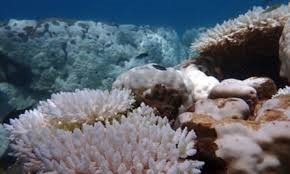
Context
- A severe mass coral bleaching event, described as unprecedented, is currently unfolding along Australia’s western coast, severely impacting the Ningaloo Reef, a UNESCO World Heritage site. This event is part of the fourth global coral bleaching episode, which has been ongoing since 2023.
Global Impact of Coral Bleaching
- The National Oceanic and Atmospheric Administration (NOAA) reports that nearly 84% of the world’s reef areas have experienced bleaching-level heat stress, affecting over 80 countries and territories.
- Rising global sea surface temperatures, overfishing, and pollution have exacerbated the crisis, with climate change being a primary driver.
Coral Reefs: An Overview
What Are Coral Reefs?
- Coral reefs are complex underwater ecosystems built by reef-building corals.
- Composed of colonies of coral polyps bound by calcium carbonate.
- Coral polyps live in a mutualistic relationship with algae known as zooxanthellae, which provide them with nutrients through photosynthesis.
Favorable Conditions for Coral Growth
- Temperature: 20°C–35°C
- Salinity: 27%–40%
- Depth: Prefer shallow waters (less than 50 meters) for optimal sunlight exposure.
- Major Coral Reefs Around the World
- Global Coral Reefs
- Great Barrier Reef (Australia) – UNESCO World Heritage Site
- Caribbean Reefs – Florida, Belize, and Bahamas
- Coral Triangle (Southeast Asia) – Indonesia, Malaysia, and the Philippines
- Coral Reefs in India
- Gulf of Kutch (Gujarat)
- Gulf of Mannar (Tamil Nadu)
- Andaman & Nicobar Islands
- Lakshadweep Islands
- Malvan (Maharashtra)
- Significance of Coral Reefs
- Biodiversity Hotspot – Support 25% of all marine species.
- Coastal Protection – Act as natural barriers against storms and erosion.
- Climate Mitigation – Aid in carbon sequestration.
- Blue Economy – Sustain livelihoods through fishing and tourism.
- Biomedical Resources – Source of antiviral and anticancer compounds.
- Threats to Coral Reefs
Climate-Related Threats
- Coral Bleaching – Caused by rising ocean temperatures.
- Ocean Acidification – Weakens coral skeletons due to increasing CO₂
- Algal Blooms – Triggered by nutrient pollution, suffocating corals.
Human-Induced Threats
- Overfishing – Disrupts marine food chains.
- Pollution – Plastic waste, oil spills, and chemical runoff degrade reef health.
- Coral Mining – Unsustainable extraction for construction materials.
- Coastal Development – Leads to habitat destruction and sedimentation.
The Way Forward
- Climate Action
- Strengthen efforts to limit global warming to well below 2°C, in line with the Paris Agreement.
- Policy & Governance
- Implement Sustainable Development Goals (SDGs), particularly:
- SDG 8 (Sustainable Economic Growth)
- SDG 12 (Responsible Consumption & Production)
- Global Collaboration
- Strengthen international partnerships to combat overfishing and marine pollution.
- Scientific Innovation
- Invest in R&D for climate-resilient coral species to enhance reef restoration efforts.
- By integrating policy, conservation, and innovation, proactive measures can help protect the world’s coral reefs from irreversible decline.
With reference to coral bleaching, consider the following statements:
- Coral bleaching occurs when corals expel their symbiotic algae due to increased ocean salinity.
- Ocean acidification can exacerbate coral bleaching by weakening coral skeletons.
- The Great Barrier Reef is the only coral reef system listed as a UNESCO World Heritage Site.
Which of the statements given above is/are correct?
(a) 1 and 2 only
(b) 2 only
(c) 1 and 3 only
(d) 1, 2, and 3
Answer: (b) 2 only
Explanation:
- Statement 1 is incorrect – Coral bleaching occurs due to rising sea surface temperatures, not increased salinity. The stress forces corals to expel zooxanthellae algae, leading to their white appearance.
- Statement 2 is correct – Ocean acidification, caused by increased CO₂ absorption in seawater, weakens coral skeletons and makes them more vulnerable to bleaching and erosion.
- Statement 3 is incorrect – The Great Barrier Reef is a UNESCO World Heritage Site, but other coral reefs like Ningaloo Reef (Australia) and Belize Barrier Reef (Caribbean) are also listed.
Wage Hike of MGNREGS
Syllabus :GS 2/Welfare Schemes
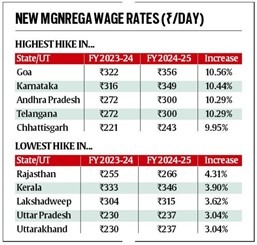
Recent Developments
- The Union government has announced an increase in wages under the Mahatma Gandhi National Rural Employment Guarantee Scheme (MGNREGS), ranging from 2% to 7% for the financial year 2025-26.
Key Highlights of Wage Revisions
- The wage hike varies between ₹7 to ₹26 across different states.
- States with the lowest increase (₹7): Andhra Pradesh, Arunachal Pradesh, Assam, Nagaland, and Telangana.
- Haryana recorded the highest wage increase (₹26), making it the first state to reach ₹400 per day under MGNREGS.
Understanding MGNREGA
Objective & Scope
- Demand-driven wage employment program, where resource allocation from the Centre to states is based on actual employment demand.
- Guarantees 100 days of wage employment per year to rural households whose adult members volunteer for unskilled manual work.
Types of Work Covered
- MGNREGA includes 266 categories of work, primarily focused on:
- Agriculture and allied activities
- Natural resource management (water conservation, afforestation, soil erosion control)
- Rural infrastructure development (roads, irrigation projects, flood control structures)
Wage Calculation Mechanism
- Wages under MGNREGA are linked to the Consumer Price Index for Agricultural Labourers (CPI-AL) to ensure adjustments for inflation in rural areas.
- In FY 2024-25, Goa recorded the highest wage hike (56%), whereas Uttar Pradesh and Uttarakhand had the lowest (3.04%).
Budgetary Allocation & Financial Trends
- MGNREGA’s budget has seen a significant rise from ₹11,300 crore in 2006-07 to ₹86,000 crore in FY 2024-25.
- A record ₹1,11,000 crore was allocated in FY 2020-21 to address economic distress caused by COVID-19.
Women’s Participation & Digital Reforms
- Women’s participation in MGNREGA has grown from 48% in FY 2013-14 to over 58% in FY 2024-25, reflecting greater financial inclusion.
- Introduction of digital payment systems has improved efficiency and transparency:
- Aadhaar-Based Payment System (ABPS): Ensures targeted wage disbursal, covering 49% of active workers.
- National Mobile Monitoring System (NMMS): Prevents fraudulent attendance and enhances accountability.
- National Electronic Fund Management System (NeFMS): Enables 100% electronic wage disbursement under Direct Benefit Transfer (DBT), making MGNREGA the largest DBT-based scheme in India.
Conclusion
- The recent wage hike under MGNREGS reflects the government’s commitment to strengthening rural employment, ensuring inflation-linked wage adjustments, and enhancing transparency through digital governance.
- However, challenges such as funding delays, timely wage payments, and worksite monitoring need continuous policy attention for improved effectiveness.
With reference to the implementation of MGNREGA, consider the following statements:
- Every rural household in India is entitled to 100 days of guaranteed wage employment per individual per year under MGNREGA.
- The payment of wages under MGNREGA must be completed within 15 days from the date of work completion, failing which the government is liable to pay compensation.
- The National Mobile Monitoring System (NMMS) has been introduced to digitally capture attendance at MGNREGA worksites to reduce fraudulent claims.
Which of the statements given above is/are correct?
(A) 1 and 2 only
(B) 2 and 3 only
(C) 1 and 3 only
(D) 1, 2, and 3
Answer: (B) 2 and 3 only
Explanation:
- Statement 1 is incorrect → MGNREGA guarantees 100 days of wage employment per household, not per individual. The scheme provides work for adult members of a rural household willing to do unskilled manual labor.
- Statement 2 is correct → As per Section 3 of the MGNREGA Act, 2005, wages must be paid within 15 days of work completion. If delayed, the government is liable to pay compensation as per the Payment of Wages Act, 1936.
- Statement 3 is correct → The National Mobile Monitoring System (NMMS) was introduced in 2021 to ensure real-time digital attendance recording, reducing fake beneficiaries and improving transparency.
India becomes World’s 2nd-largest Exporter of Tea in 2024
Syllabus: GS3/Economy
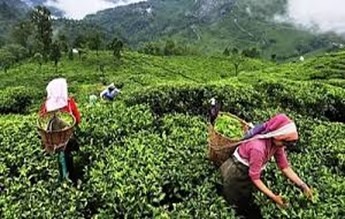
Overview
- According to the Indian Tea Board, India has emerged as the second-largest tea exporter globally, surpassing Sri Lanka and trailing only Kenya.
India’s Tea Exports (2024)
- Total Exports: 255 million kg
- Growth: Export value surged by 15%, from ₹6,161 crore in 2023 to ₹7,111 crore in 2024
- Tea Varieties Exported:
- Black Tea – Dominates exports (96%)
- Other varieties include regular, green, herbal, masala, and lemon tea
Key Factors Driving Growth
- Increased demand from West Asia, with Iraq now constituting 20% of India’s tea exports
- Projected Imports by Iraq: Expected to reach 40-50 million kg in FY 2024-25
- Expansion into over 25 markets, including UAE, Iraq, Iran, Russia, US, and UK
- Branding efforts and improved tea workers’ welfare have strengthened India’s global position
- Major Tea-Producing Regions
- Assam: Assam Valley, Cachar
- West Bengal: Dooars, Terai, Darjeeling
- Other notable varieties: Assam, Darjeeling, and Nilgiri teas, recognized for their superior quality
Tea Board of India
- Established: 1954 under the Tea Act, 1953
- Purpose: Regulates the Indian tea industry and safeguards the interests of producers
Governing Body:
- Comprises 32 members, including the Chairman and Deputy Chairman, appointed by the Government of India
- Headquarters: Kolkata
- Authority: Administers all tea-producing regions across India
- India’s tea industry continues to flourish, bolstered by strategic market expansion, quality branding, and increased global demand
With reference to India’s tea exports, consider the following statements:
- India has overtaken both Sri Lanka and Kenya to become the largest tea exporter in the world.
- Iraq has emerged as a key importer of Indian tea, accounting for nearly 20% of India’s total tea exports.
- The majority of India’s tea exports comprise green tea due to rising global health consciousness.
Which of the statements given above is/are correct?
(a) 1 and 3 only
(b) 2 only
(c) 1 and 2 only
(d) 1, 2, and 3
Answer: (b) 2 only
Explanation:
Statement 1 is incorrect: India is the second-largest tea exporter, having surpassed Sri Lanka but not Kenya, which remains the largest.
Statement 2 is correct: Iraq has become a major importer, accounting for 20% of India’s tea exports in 2024.
Statement 3 is incorrect: Black tea constitutes 96% of India’s exports, not green tea.
